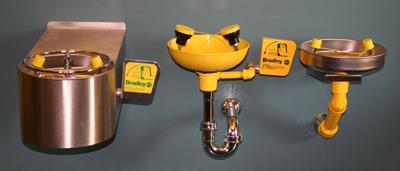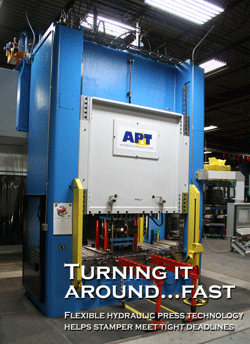- FMA
- The Fabricator
- FABTECH
- Canadian Metalworking
Categories
- Additive Manufacturing
- Aluminum Welding
- Arc Welding
- Assembly and Joining
- Automation and Robotics
- Bending and Forming
- Consumables
- Cutting and Weld Prep
- Electric Vehicles
- En Español
- Finishing
- Hydroforming
- Laser Cutting
- Laser Welding
- Machining
- Manufacturing Software
- Materials Handling
- Metals/Materials
- Oxyfuel Cutting
- Plasma Cutting
- Power Tools
- Punching and Other Holemaking
- Roll Forming
- Safety
- Sawing
- Shearing
- Shop Management
- Testing and Measuring
- Tube and Pipe Fabrication
- Tube and Pipe Production
- Waterjet Cutting
Industry Directory
Webcasts
Podcasts
FAB 40
Advertise
Subscribe
Account Login
Search
Turning it around (fast)
Flexible hydraulic press technology helps stamper meet tight customer deadlines
- August 8, 2007
- Article
- Bending and Forming
As offshore suppliers become fierce low-price competitors, many U.S. stampers are facing stark choices. To avoid further market share erosion, some are differentiating their offerings by creating a niche market or offering value-added services.
For the Bradley Corp., an 85-year-old plumbing and metal fixtures manufacturer in Menomonee Falls, Wis., its differentiator is the ability to meet tight customer deadlines.
According to Ron Walter, manufacturing engineer at Bradley, the plant has reached 99 percent on-time delivery in ever-tightening market cycles. "We've proven to our customers that we'll deliver exactly what they want, when they need it," Walter said. "This gives us a huge advantage when we're bidding against foreign suppliers whose products can take weeks to get from factory floor to the job site."
The strategy is paying off.
While other Midwest manufacturers are struggling, Bradley is projecting it will significantly increase production over the next four years. This growth is attributed to the stamper's flexibility—its ability to adapt equipment, processes, and scheduling to quickly turn around incoming customer orders.
Exceeding Capabilities
Bradley's flexibility got its start with an AP&T ZM 550-ton hydraulic press. "The press is where it all starts for most of our product lines," Walter said. "The faster we can process product through primary forming, the faster we can get product out the door. Because of the new press, we have greater capabilities, higher availability, better productivity, and fewer restrictions. We've increased throughput through the entire plant."
For decades the stamper's draw pressing was done with a pre-World War II, 900-ton hydraulic press. Although carefully maintained and updated over the years, the technology was too slow to keep up with a growing and complex work load. Bradley's evolving product line began to include many small parts, such as 12-inch-diameter eyewash bowls, for which a 900-ton press was overkill (see Figure 1).
These newer parts also were more intricate and posed forming challenges the old press had a hard time meeting. In some cases, a single part took a day and a half to get through the setup, drawing, forming, and trimming steps required to prepare it for further production. This created availability and scheduling headaches as well as bottlenecks. Squeezing required nighttime maintenance in between a constant flow of jobs was challenging and, at times, came in second to production concerns.
Operator safety and ergonomics also were issues. Although the hydraulic press had all the required safety features, its mechanical guards made it intimidating when operators had to reach into the press to load or unload the unit, especially for small parts. This also increased the risk of operator strain and injury.
Additional press capacity was needed to accommodate increasing production requirements and tighter deadlines. "At 60,000 strokes a year, the old press was maxed out," Walter said. "A second press was essential to keep production moving if the old press was down for repairs."

Figure 1Bradley Corp.'s evolving product line began to include many small parts, such as 12-in.-dia. eyewash bowls, for which a 900-ton press was overkill.
Contingency planning was one of the biggest motivators for the purchase. "We couldn't make an effective plan with just a single press," Walter said. "If it went down, it would affect everything in the plant, and we'd start missing deadlines."
The existing 900-ton hydraulic press was still well-suited for running bigger parts, such as classic deep wash fountains (see Figure 2). Plus, the old press would serve as an essential backup for the new press. The risks of putting off a press acquisition had become too great. The potential advantages could help the stamper take its customer responsiveness to a new level.
Finding the Right Hydraulic Press
The hydraulic press needed to provide fast start-up and operating speeds to maximize productivity and flexibility. Advanced, user-friendly control and programming capabilities were needed to accommodate a range of products and operations—including drawing, forming, blanking, and pinching off. "Our goal was to transfer 90 percent of the work load from the old press to the new press," Walter said.
"The new press would be taking the brunt of the work, and even though the old press would serve as a backup, it was essential to have the most trouble-free operation possible," Walter said. "Each of the presses and press suppliers we looked at could clearly do a good job for us, but we decided the ZM hydraulic press could take production to another level."
To fit the new press into place without cutting holes in the plant's 18-foot ceiling, AP&T redesigned the machine, lowering the hydraulic unit from the back of the press frame to a new location.
Switching from a 70-year-old press to a brand-new press loaded with advanced technology required adjusting setup, tooling, production, and operational procedures for every part. "The old part parameters couldn't even be used as guidelines," Walter said. Operators found that press features such as recipe management embedded in the controls allowed them to reduce setup time about 75 percent on the most complex parts.
Bradley's new hydraulic press operates at twice the cycling speed of the old press, with the most dramatic improvements observed while producing complex parts. "If we need to, we can get as much out in one shift as we used to in two," Walter said.
Meanwhile, press operation and part quality have improved. "This new technology allows us to fine-tune operating parameters," Walter said. "We've been able to considerably improve entire processes using these capabilities."
Even though it was their first experience with a state-of-the-art hydraulic press, operators were able to pick up things quickly and are cross-training other plant personnel to expand the pool of qualified press operators. The stamper also is maximizing flexibility by modifying press tooling so it can be installed easily on either press.
The new press eliminated scheduling and availability hassles that plagued the production process. "The first thing we did after the new press was online was take the old press offline for comprehensive nighttime maintenance, something we couldn't even consider before," Walter said. "Because we now have a backup press, we can do planned and unplanned maintenance on either press without interrupting or outsourcing critical work flow."

Figure 2The old 900-ton hydraulic press was still well-suited for running bigger parts, such as classic deep wash fountains.
Most important, the new press is producing the desired results where it matters most—on-time delivery with short lead-times. Before the new press was installed, on-time deliveries to internal and external customers were below 90 percent. In the months since the press bottleneck was removed, on-time deliveries have increased to 99 percent.
"The new press has done everything the supplier said it would do," Walter said. "Our setup, run-time, and productivity goals have all been met."
Not too long ago making plant investment decisions was a straightforward proposition. Today, however, investments such as new presses often need to be considered in terms that aren't easily quantifiable by traditional return-on-investment parameters.
It's not just the cost of production that needs to be taken into account, but also the cost of developing a unique strength that offshore competition can't match, Walter commented. "There's an attitude from the top down in this company to do whatever it takes to stay competitive, to keep our plant open and our people employed. When we visited the AP&T plant in Sweden, it opened our eyes to the potential of press automation, so now we're considering that. We're determined to acquire any technology that helps us compete on our own terms," he said
"We know what we're up against. And we're pretty sure we've found the right way to fight back," Walter said.
Related Companies
subscribe now

The Fabricator is North America's leading magazine for the metal forming and fabricating industry. The magazine delivers the news, technical articles, and case histories that enable fabricators to do their jobs more efficiently. The Fabricator has served the industry since 1970.
start your free subscription- Stay connected from anywhere

Easily access valuable industry resources now with full access to the digital edition of The Fabricator.

Easily access valuable industry resources now with full access to the digital edition of The Welder.

Easily access valuable industry resources now with full access to the digital edition of The Tube and Pipe Journal.
- Podcasting
- Podcast:
- The Fabricator Podcast
- Published:
- 04/16/2024
- Running Time:
- 63:29
In this episode of The Fabricator Podcast, Caleb Chamberlain, co-founder and CEO of OSH Cut, discusses his company’s...
- Trending Articles
AI, machine learning, and the future of metal fabrication

Employee ownership: The best way to ensure engagement

Steel industry reacts to Nucor’s new weekly published HRC price

How to set a press brake backgauge manually

Capturing, recording equipment inspection data for FMEA

- Industry Events
16th Annual Safety Conference
- April 30 - May 1, 2024
- Elgin,
Pipe and Tube Conference
- May 21 - 22, 2024
- Omaha, NE
World-Class Roll Forming Workshop
- June 5 - 6, 2024
- Louisville, KY
Advanced Laser Application Workshop
- June 25 - 27, 2024
- Novi, MI



























